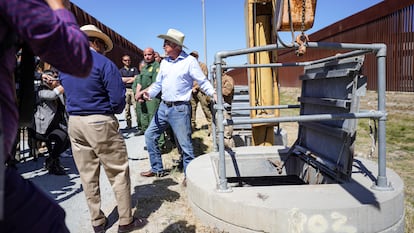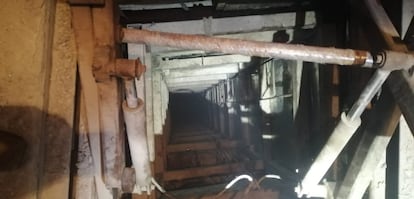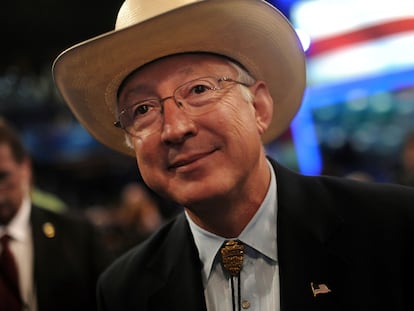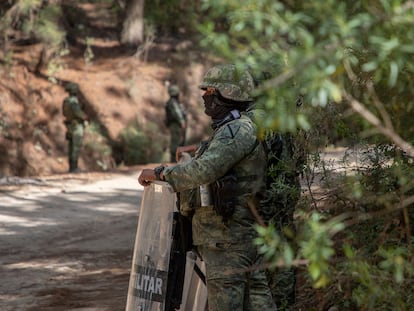‘Narco-tunnels’ become a factor in US-Mexico relations
Authorities found a passageway for drug trafficking in Tijuana a few days after Ambassador Ken Salazar noted the presence of more than 200 on the border

More than 300 meters long, 10 meters deep and fully lit: so is the latest narco-tunnel that authorities have found in Tijuana, on the border between Mexico and the United States. The underground corridor was used to traffic drugs to San Diego, California, and has since been closed. The discovery was not an accident: US Ambassador Ken Salazar had warned last week of the presence of over 200 tunnels during a visit to the border city.
The tunnel was discovered last weekend after a joint operation by the Mexican Army, the Tijuana Police and the Attorney General’s Office. The entrance is located under a house in the Nueva Tijuana neighborhood, a few meters from the Otay border crossing where Salazar made those statements. The passageway, reinforced with metal beams, remains under police protection. Authorities have not identified which criminal group used it, but six people have been arrested.
Mexican authorities emphasized that communication with their US counterparts had been “close” and that bilateral collaboration had been key to finding the tunnel. Less than 48 hours earlier, Salazar had made the same points. “Working with the Mexican government, we have a very good collaboration in trying to eradicate these tunnels, which should not be here, because this is where a lot of crime happens, a lot of suffering,” said the ambassador in statements collected by the weekly newspaper Zeta. “This must stop,” he added.

Salazar’s visit to Tijuana included a tour of a narco-tunnel discovered in 2009. The passageway, which also crosses the border wall, is known as Gálvez and is 270 meters long and 30 meters deep. The structure’s construction was attributed to the Arellano Félix cartel, a criminal organization created in the 1980s, which dominated the movement of drugs to the United States in that area for decades.
After the tour, Salazar, senior US anti-narcotics officials and Mexican Foreign Minister Marcelo Ebrard held a press conference announcing a $4.2 billion investment to reinforce the border. Ebrard exhorted the authorities of both countries to “be more effective at the border against fentanyl, drugs and weapons that come and go on both sides.”
“[We intend] to ensure that this border is a place where people can walk from one place to another safely and where trade continues in a better way than now,” Salazar said. Last month, Texas governor Greg Abbott imposed tough security checks that virtually paralyzed cross-border trade. (More than 2,000 of the 3,000 kilometers between the two countries pass through Abbott’s state.)
Following the White House’s appeal to stop drug trafficking from Mexico, the government of Andrés Manuel López Obrador has urged the United States to do the same with the smuggling of firearms. More than 500,000 US weapons arrive in the Latin American country each year, according to Mexican authorities, who began working to prosecute the US arms industry last year.
Less than a week ago, another tunnel made headlines in Culiacán, the stronghold of the Sinaloa Cartel, the organization historically led by Joaquín “El Chapo” Guzmán. A young man who was sleeping on the sofa in his house fell after a hole opened in the ground. The hole in the floor was attributed to the existence of the underground passageway, found in 2011.
El Chapo had escaped in July 2015 from the Altiplano prison, a high-security prison in central Mexico, through a tunnel that took members of his criminal organization more than a year to build. In the videos broadcast from his cell, the criminal leader is seen disappearing from one moment to the next after going through a hole in the floor. Guzmán traveled more than a kilometer underground on a motorcycle. The capo was captured in early 2016 and extradited to the United States a year later. Guzmán had previously managed to evade several capture operations through underground networks of passages. The first tunnel attributed to him dates from 1989.
The longest known narco-tunnel measured more than two kilometers, and its discovery was announced in January 2020. It had tracks, air conditioning, an elevator and electricity. The entrance was in Tijuana and the exit in San Diego. “The sophistication of this tunnel demonstrates the determination and monetary resources of the cartels,” the US border patrol said at the time. Despite the spectacular announcement, the news came with no information about arrests.
Tu suscripción se está usando en otro dispositivo
¿Quieres añadir otro usuario a tu suscripción?
Si continúas leyendo en este dispositivo, no se podrá leer en el otro.
FlechaTu suscripción se está usando en otro dispositivo y solo puedes acceder a EL PAÍS desde un dispositivo a la vez.
Si quieres compartir tu cuenta, cambia tu suscripción a la modalidad Premium, así podrás añadir otro usuario. Cada uno accederá con su propia cuenta de email, lo que os permitirá personalizar vuestra experiencia en EL PAÍS.
¿Tienes una suscripción de empresa? Accede aquí para contratar más cuentas.
En el caso de no saber quién está usando tu cuenta, te recomendamos cambiar tu contraseña aquí.
Si decides continuar compartiendo tu cuenta, este mensaje se mostrará en tu dispositivo y en el de la otra persona que está usando tu cuenta de forma indefinida, afectando a tu experiencia de lectura. Puedes consultar aquí los términos y condiciones de la suscripción digital.
More information
Últimas noticias
Brazil seduces tourists once more: Over nine million visitors and a new record
Gaza’s environmental apocalypse: ‘What we have left is not soil, it’s contaminated waste’
The end of TPS threatens thousands of Haitians in Miami: ‘Returning is a death sentence’
Release of political prisoners in Venezuela: a gesture of openness under Trump’s shadow
Most viewed
- Charles Dubouloz, mountaineering star, retires at 36 with a farewell tour inspired by Walter Bonatti
- CBS in crisis after pulling a report on Trump’s deportations to El Salvador (which later leaked online)
- December Social Security and SSI payments: Dates, double checks and the 2026 COLA increase
- Bukele clan fumes over investigation exposing their new wealth
- The Florida Keys tourist paradise is besieged by immigration agents: ‘We’ve never seen anything like this’











































